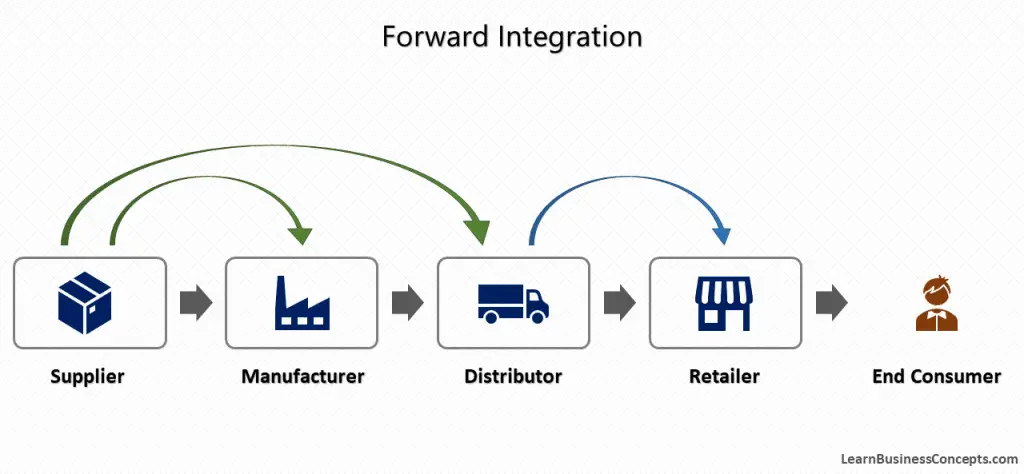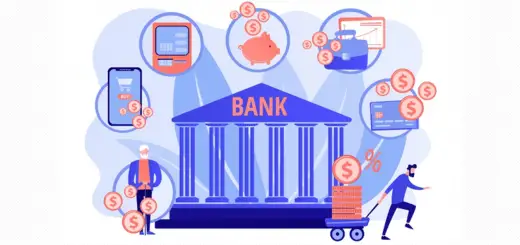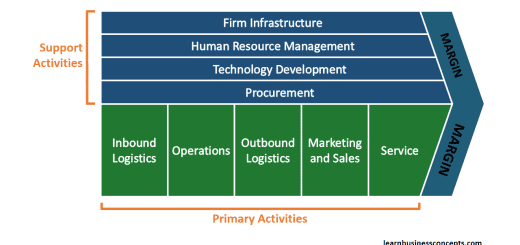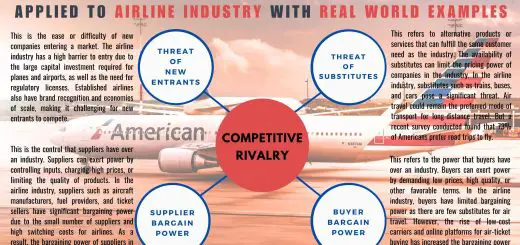Forward Integration Definition with Real Industry Examples
Definition of Forward Integration
Forward integration is a strategy where the company gains control of the business activities that are ahead in the value chain. This is a type of vertical integration of the supply chain. Forward integration practically means “removing the middleman”. Manufacturers may skip the wholesalers/retailers in the value chain to sell directly to customers.
The main trick of forward integration lies in effectively gaining control over downstream processes while enhancing the overall value proposition to customers. This involves ensuring that forward integration initiatives align with the company’s strategic goals and long-term vision, thereby enhancing competitive advantage and growth prospects.
Understanding customer needs and market demand is crucial, as it allows for tailored offerings and improved customer engagement. Streamlining processes and ensuring seamless coordination between manufacturing and distribution can reduce costs and enhance efficiency. Additionally, companies must prepare for the significant financial investment required and allocate the necessary resources, including skilled personnel and technological capabilities. Maintaining brand consistency and providing a superior customer experience are also essential to successfully executing forward integration.
How does Forward Integration Work?
Forward integration simply means the company takes control of the business activities ahead in its value chain. Let’s think about a shoe production company. The company produces the shoes and it opens its shoe retail outlet as well. So the company will directly sell its designs to customers instead of selling them through other retail stores.

Why do Companies Follow Forward Integration?
There are many reasons for a company to follow Forward Integration,
1. Enhanced Control Over Distribution
Forward integration allows companies to gain greater control over the distribution of their products. By owning or managing the channels through which their products reach consumers, companies can ensure that their goods are presented and sold in a manner that aligns with their brand values and customer expectations. For instance, Apple’s retail stores provide a uniform and high-quality shopping experience, reinforcing its premium brand image.
2. Improved Customer Experience
Direct engagement with customers enables companies to offer a better overall experience. This includes better customer service, personalized offerings, and quicker resolution of issues. For example, Tesla’s showrooms and service centers allow the company to directly address customer inquiries and maintenance needs, enhancing customer satisfaction and loyalty.
3. Increased Profit Margins
By eliminating intermediaries, companies can capture more of the value chain, leading to higher profit margins. Retailers and distributors typically take a share of the profits, so by selling directly to consumers, companies like Nike and Warby Parker can retain a larger portion of the sales revenue.
4. Better Market Insights
Forward integration provides companies with direct access to consumer data and market trends. This real-time feedback is invaluable for making informed decisions about product development, marketing strategies, and inventory management. Zara, for instance, leverages data from its own stores to quickly adapt its fashion lines to changing consumer preferences.
5. Brand Loyalty and Differentiation
Owning the customer relationship helps in building stronger brand loyalty. Companies can create unique brand experiences that differentiate them from competitors. Starbucks’ coffee shops are a prime example, where the company’s control over the retail environment enhances the overall brand experience and fosters customer loyalty.
6. Streamlined Supply Chain
Forward integration can lead to a more streamlined and efficient supply chain. Companies can reduce delays and inefficiencies that often occur when relying on external distributors. Amazon’s investment in its logistics and delivery network ensures fast and reliable order fulfillment, a key component of its customer satisfaction strategy.
7. Competitive Advantage
Gaining direct access to customers can provide a significant competitive advantage. Companies can better protect their market position and respond more swiftly to competitive threats. Disney’s launch of Disney+ allows it to compete directly with other streaming services by leveraging its vast content library and brand strength.
8. Revenue Diversification
Forward integration can open up new revenue streams. For instance, a manufacturer moving into retail can earn revenue from both product sales and retail operations. This diversification can help stabilize revenue and reduce dependence on any single segment of the supply chain.
9. Enhanced Product Customization
Companies can offer customized products or services directly to consumers with forward integration. This level of customization can drive higher customer satisfaction and increase sales. Dell, for example, allows customers to configure their computers according to their preferences directly through its website.
Real Industry Examples of Forward Integration
Following are some real world industry examples of forward integration,
1. Nike introduces Direct-to-Consumer Sales since 2011
Nike has employed forward integration by opening its own branded retail stores and selling products directly through its website and mobile app. This strategy enables Nike to directly engage with customers, offer exclusive products, and gather valuable consumer data to improve marketing and product development efforts.
The sportswear giant Nike has grown Direct-to-Consumer sales since 2011 which enables them to sell their products directly to their end customers, without selling through the value chain of the outlet, retailer, distributor, wholesaler. This is an industry example of forward integration.
2. The Walt Disney Company introduced Disney+
Disney has utilized forward integration by acquiring and developing its own distribution channels, including Disney+ streaming service. By owning the platform that delivers its content, Disney can directly reach consumers, control the user experience, and capture subscription revenues, enhancing its competitive edge in the entertainment industry.
The Walt Disney Company introduced Disney+ in 2019, which enables them to stream on-demand videos directly to their end customers.
3. Apple had Launched their own Retail Stores
Apple is a prime example of forward integration. The company designs and manufactures its own products and sells them directly to consumers through its Apple Stores and online platform. This strategy allows Apple to control the customer experience, pricing, and product presentation, contributing to its strong brand loyalty and high profit margins. Now Apple has many retail stores which increased customer satisfaction more.
Reference: A tale of two Apple Stores (the first two) – macworld.com
4. McDonald’s acquired Dynamic Yield to improve their Digital Customer Experience
McDonald’s acquired a tech company called Dynamic Yield in 2019. Company plans to improve their digital customer experience touchpoints with this acquiring. The technology allows menus at McDonald’s drive-thrus to change based on different factors including weather, current traffic, and more. This is an example of forward integration.
5. Amazon introduced Amazon Prime in 2005
Amazon is another example of forward integration. Besides being a leading e-commerce platform, Amazon has established its own logistics and delivery network, including Amazon Prime and Amazon Fresh. This allows the company to control the entire process from order placement to delivery, ensuring fast and reliable service.
Amazon introduced Amazon Prime in 2005 which customers can experience free two-day delivery service for the goods purchased in a comparatively lower price. This can be considered as a forward integration which is optimizing the delivery value chain.
6. Tesla Inc
Tesla uses forward integration by selling its electric vehicles directly to consumers through its own network of showrooms and online store. Additionally, Tesla has developed a comprehensive charging network, enhancing the customer experience and ensuring that customers have convenient access to charging facilities, further strengthening its market position.
What should Companies Consider before Forward Integration
Company management should consider many crucial factors before embark on forward integration. This ensures the move aligns with their overall strategy and provides the anticipated benefits. Here are the key considerations,
1. Market Demand and Customer Needs
Assess the demand for the products or services at the next stage in the supply chain. Ensure there is sufficient market potential to justify the move. Company have to gather comprehensive insights into customer preferences and behavior to tailor offerings effectively.
2. Financial and Resource Capabilities
Company management should analyze the financial investment needed for forward integration, including costs related to acquisition, infrastructure, technology, and human resources. Also should ensure the company has the necessary resources, including skilled personnel and technological capabilities, to manage the new operations.
3. Competitive Landscape
Company management should evaluate the competitive environment and understand the strengths and weaknesses of existing players in the downstream market. Also should determine how forward integration will enhance the company’s competitive position and create a unique value proposition.
4. Operational Efficiency
Company should identify potential synergies between existing operations and the new forward-integrated activities. Have to look for opportunities to streamline processes and reduce costs. Also the management should ensure seamless coordination between upstream and downstream activities to maintain efficiency and avoid disruptions.
5. Risk Management
Company management should conduct a thorough risk assessment to identify potential challenges and uncertainties associated with forward integration. Company should develop strategies to mitigate identified risks, including contingency plans for potential setbacks.
6. Regulatory and Legal Considerations
It is critical to understand and comply with relevant regulations, laws, and industry standards in the downstream market. Company should ensure the protection of intellectual property rights and assess any legal implications of entering the new market.
7. Strategic Alignment
Management has to ensure that forward integration aligns with the company’s long-term strategic goals and vision. It is essential to consider the cultural fit between the existing organization and the new operations to ensure a smooth integration process.
8. Customer Relationship Management
Company management should develop strategies to manage and nurture relationships with existing customers while expanding to new segments. It is vital to assess the impact of forward integration on the company’s brand and reputation.
9. Technological Capabilities
It is best to make sure that the technology used in the downstream operations is compatible with existing systems. Company must evaluate the potential for leveraging new technologies to enhance product offerings and customer experience.
10. Scalability and Flexibility
It is a must to assess the scalability of the new operations and their potential for future growth. Company management has to ensure the integrated operations can adapt to changing market conditions and customer needs.
Forms of Forward Integration
Forward integration can take several forms, depending on the company’s objectives, industry, and market dynamics. Here are some detailed explanations of the main forms or types,
1. Direct Sales Channels
- Company-Owned Retail Stores: Companies establish their own physical retail outlets to sell their products directly to consumers. This allows for greater control over the customer experience, brand presentation, and pricing strategies.
- Online Sales Platforms: Setting up an e-commerce website or mobile app to sell products directly to consumers online. This type of forward integration helps reach a broader audience, reduces reliance on third-party platforms, and collects valuable customer data.
2. Acquisition of Distribution Networks
- Purchasing Distributors: Companies acquire existing distribution businesses to control the distribution network and ensure that their products are delivered efficiently and effectively to retailers or end consumers.
- Establishing Logistics and Warehousing: Creating or acquiring logistics and warehousing facilities to manage inventory, streamline supply chain operations, and reduce dependency on third-party logistics providers.
3. Franchising and Licensing
- Franchising: Granting independent operators (franchisees) the right to operate retail outlets or service centers under the company’s brand and business model. This expands market reach while maintaining brand standards and benefiting from the franchisee’s local market knowledge.
- Licensing: Allowing other companies to produce and sell products under the company’s brand. This helps expand the brand’s presence in new markets without the need for direct investment in manufacturing or distribution.
4. Strategic Partnerships and Alliances
- Joint Ventures: Forming joint ventures with other companies to share resources, expertise, and market access. This can involve creating new distribution channels or expanding existing ones in collaboration with partners.
- Alliances with Retailers: Establishing strategic partnerships with established retailers to ensure prominent shelf space, better terms, and enhanced visibility for the company’s products.
5. Developing Service Centers
- After-Sales Service Centers: Setting up company-owned service centers to provide maintenance, repair, and customer support directly to consumers. This improves customer satisfaction and loyalty by ensuring high-quality service.
- Customer Experience Centers: Creating experiential spaces where customers can interact with the brand and its products in a more engaging way. These centers can offer demonstrations, workshops, and personalized consultations.
6. Product Customization and Personalization
- Customization Platforms: Developing platforms where customers can customize and personalize products according to their preferences. This direct interaction with consumers enhances brand loyalty and provides valuable insights into customer trends.
Each type of forward integration allows companies to gain more control over their products’ market presence, improve customer relationships, and ultimately enhance their competitive advantage.
Difference Between Forward Integration and Backward Integration
- Forward Integration involves a company expanding its operations downstream in the supply chain, moving closer to the end consumer. On opposite, Backward Integration involves a company expanding its operations upstream in the supply chain, moving towards raw materials and production stages.
- The primary goal of Forward Integration is to gain greater control over the distribution and sale of products or services. Main objective of Backward Integration is to secure a reliable supply of critical inputs and reduce dependency on external suppliers.
- Forward Integration focuses on acquiring or merging with businesses at later stages in the supply chain, such as distributors, retailers, or direct sales platforms. On other hand, Backward Integration focuses on acquiring or merging with suppliers or producers of raw materials and components.
- Forward Integration offers enhanced market presence, improved customer engagement, increased profit margins by eliminating intermediaries, and better insights into consumer behavior. Backward Integration provides a secured supply chain, reduced supply risks, enhanced quality control, and lower production costs through economies of scale.
- Example of Forward Integration is which a smartphone manufacturer opening its own branded retail stores to sell directly to consumers. Example of Backward Integration is where a bakery chain acquiring a flour mill to secure a steady and cost-effective supply of high-quality flour.
Difference Between Forward Integration and Vertical Integration
- Forward Integration is a specific type of vertical integration where a company moves downstream in the supply chain, closer to the end consumer. Vertical Integration is a broader strategy where a company expands its operations either upstream (backward) or downstream (forward) in the supply chain, or both.
- Forward Integration only focuses on expanding into activities that are downstream, such as distribution, sales, and retail. On other hand, Vertical Integration encompasses both upstream (backward integration) and downstream (forward integration) activities, covering the entire supply chain.
- Forward Integration aims to control the distribution and sale of products or services to enhance market presence and customer engagement. In contrast, Vertical Integration aims to control multiple stages of the supply chain to improve efficiency, reduce costs, secure supplies, and control the market.
- Forward Integration specifically targets acquiring or merging with distributors, retailers, or direct sales platforms. But Vertical Integration includes acquiring or merging with suppliers, producers of raw materials, distributors, retailers, and any intermediary stages in the supply chain.
- Example of Forward Integration is where a car manufacturer opening its own network of dealerships. Example of Vertical Integration is which clothing brand that owns textile factories (backward integration) and retail stores (forward integration).
Pros / Benefits of Forward Integration
1. Increased Control Over Distribution
Companies can directly manage how their products are delivered to customers, ensuring consistency in quality and service.
2. Higher Profit Margins
By eliminating intermediaries, companies can reduce distribution costs and capture more value, leading to higher profit margins.
3. Improved Customer Relationships
Direct interaction with customers allows for better understanding of their needs and preferences, leading to enhanced customer satisfaction and loyalty.
4. Brand Image and Experience Control
Companies can ensure that their brand is represented consistently and positively across all customer touchpoints, from retail stores to online platforms.
5. Market Information and Insights
Direct access to end consumers provides valuable data and insights into market trends, customer behavior, and preferences, which can inform product development and marketing strategies.
6. Competitive Advantage
Greater control over the supply chain can provide a competitive edge by enabling faster response times to market changes and customer demands.
7. Barrier to Entry
Establishing direct distribution channels and strong customer relationships can create barriers for new entrants, protecting the company’s market position.
8. Better Coordination and Efficiency
Integrating distribution and sales operations can streamline processes, reduce inefficiencies, and enhance overall operational efficiency.
9. Enhanced Supply Chain Resilience
Reducing dependency on external distributors and retailers can make the supply chain more resilient to disruptions and market fluctuations.
10. Customization and Personalization
Companies can offer customized and personalized products directly to consumers, increasing customer satisfaction and differentiating their offerings in the market.
11. Improved Pricing Strategy
Greater control over the sales process allows for more flexible and strategic pricing, enabling companies to optimize prices based on market conditions and customer segments.
12. Economies of Scale
By expanding operations and increasing volume, companies can achieve economies of scale, reducing per-unit costs and enhancing profitability.
Cons / Drawbacks of Forward Integration
1. High Initial Costs
Significant financial investment is required to establish or acquire distribution channels, retail outlets, or e-commerce platforms.
2. Increased Operational Complexity
Managing additional stages of the supply chain adds complexity, requiring more resources, expertise, and coordination.
3. Risk of Market Saturation
Directly entering the market can lead to overexposure, especially if the company does not fully understand consumer preferences or market dynamics.
4. Limited Flexibility
Greater control over distribution and sales can reduce flexibility to adapt to market changes, as companies are more deeply invested in their existing channels.
5. Resource Diversion
Resources and focus may be diverted from the core business activities, potentially impacting overall performance and innovation.
6. Conflict with Existing Partners
Forward integration may create conflicts with existing distributors and retailers, who may feel bypassed or threatened by the company’s direct presence in the market.
7. Increased Overhead Costs
Managing additional operations involves higher overhead costs, including staffing, training, and maintenance of new facilities or platforms.
8. Regulatory and Compliance Challenges
Entering new stages of the supply chain may involve navigating complex regulatory and compliance issues, varying by region and industry.
9. Market Risk
Direct exposure to market fluctuations and consumer demand shifts can increase financial and operational risks.
10. Brand Dilution
Poor management of new distribution channels or retail outlets can lead to inconsistent customer experiences, potentially diluting the brand’s value and reputation.
11. Capital Tie-Up
Significant capital is tied up in new assets and operations, reducing liquidity and financial flexibility for other strategic initiatives.
12. Potential for Inefficiencies
Without expertise in the new areas of operation, companies may face inefficiencies and operational challenges that can negate the benefits of integration.
Risks of Forward Integration
Forward integration involves substantial financial investments, including costs for acquiring or developing new distribution channels, retail outlets, or e-commerce platforms. These significant upfront expenses can strain a company’s financial resources and impact its overall liquidity. Additionally, managing these new operations increases operational complexity, requiring more resources, expertise, and coordination, which can divert attention from core business activities and affect overall performance.
Market risks are another major concern, as direct exposure to consumer demand fluctuations can lead to financial volatility. If a company fails to accurately anticipate market trends or consumer preferences, it risks overextending itself in markets with insufficient demand. This exposure also means that economic downturns or changes in consumer behavior can directly impact the company’s sales and profitability.
Operational inefficiencies and potential conflicts with existing distribution partners pose further risks. Without adequate expertise in the new areas of operation, companies may face inefficiencies that can negate the benefits of integration. Additionally, existing distributors and retailers might feel bypassed or threatened, potentially leading to conflicts that could harm long-standing business relationships and disrupt existing supply chains.
Regulatory and compliance challenges are also significant risks in forward integration. Entering new stages of the supply chain often involves navigating complex regulatory environments, which can vary significantly by region and industry. Companies must ensure compliance with all relevant laws and regulations to avoid legal issues, fines, and reputational damage, which can be both costly and time-consuming.
FAQs of Forward Integration
1. Why do companies pursue forward integration?
- Companies pursue forward integration to gain more control over their distribution channels, reduce dependency on intermediaries, and capture higher profit margins. This strategy helps companies enhance their brand image, improve customer relationships, and obtain direct feedback from consumers. Additionally, forward integration can provide valuable market insights and data, enabling better strategic decisions and faster responses to market changes.
2. What are the benefits of forward integration?
- The benefits of forward integration include increased control over the distribution process, higher profit margins by eliminating intermediaries, improved customer relationships through direct interactions, and enhanced brand image and consistency. Companies also gain access to valuable market data and insights, which can inform product development and marketing strategies. Additionally, forward integration can provide a competitive advantage by creating barriers to entry for new competitors and enabling better coordination and efficiency across the supply chain.
3. How does forward integration differ from backward integration?
- Forward integration involves expanding operations downstream in the supply chain, closer to the end consumer, such as through retail or distribution channels. In contrast, backward integration involves expanding operations upstream, towards raw materials and production stages. The primary goal of forward integration is to gain control over distribution and sales, while backward integration aims to secure a reliable supply of inputs, reduce costs, and improve quality control.
4. What industries commonly use forward integration?
- Industries that commonly use forward integration include manufacturing, technology, retail, and consumer goods. For instance, electronics manufacturers may open branded retail stores, automotive companies might establish dealership networks, and food producers could acquire or develop their own retail outlets. The strategy is also prevalent in the fashion industry, where brands may launch their own e-commerce platforms and physical stores to sell directly to consumers.
5. What should companies consider before pursuing forward integration?
- Before pursuing forward integration, companies should assess market demand and customer needs, evaluate their financial and resource capabilities, and analyze the competitive landscape. They should also consider potential operational synergies, conduct a thorough risk assessment, and ensure compliance with regulatory requirements. Strategic alignment with the company’s long-term goals and the potential impact on existing customer relationships and brand image should also be carefully evaluated.
6. Can small businesses benefit from forward integration?
- Yes, small businesses can benefit from forward integration, although the approach may differ from larger companies. Small businesses might focus on building direct-to-consumer online platforms, opening small-scale retail outlets, or establishing strategic partnerships with local distributors and retailers. The key is to scale the forward integration efforts in line with available resources and market opportunities to achieve greater control, improved customer engagement, and enhanced profitability.
7. How does forward integration impact customer experience?
- Forward integration can significantly enhance customer experience by allowing companies to directly manage interactions with consumers. This leads to more consistent and personalized service, better alignment of products with customer preferences, and quicker resolution of issues. Companies can create tailored shopping experiences, offer customized products, and gather direct feedback to continually improve their offerings, thereby fostering stronger customer loyalty and satisfaction.
Recommended Articles:
- Vertical Integration


